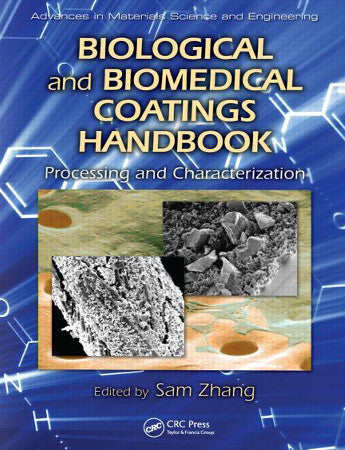This book helps the reader gain the knowledge to enable them to work in such a rapidly developing area, with a comprehensive list of references given for each chapter. Strategies for tailoring the biological response through the creation of biomaterial surfaces resistant to fouling are discussed. Methods of eliciting specific biomolecular interactions that can be further combined with patterning techniques to engineer adhesive areas in a noninteractive background are also covered.
The theoretical basis of surface engineering for improvement of biocontact properties of polymeric biomaterials as well as the current state-of-the-art of the surface engineering of polymeric biomaterials is presented. The book also includes information on the most used conventional and advanced surface engineering methods.
The book is targeted at researchers, post-doctorates, graduate students, and those already working in the field of biomaterials with a special interest in the creation of polymeric materials with improved biocontact properties via surface engineering.
1 Introduction
1.1 Specific Objectives of Biomaterial Surface Engineering
1.2 Theoretical Basis of Biomaterial Surface Engineering
1.2.1 Protein Adsorption
1.2.1.1 Specific Protein Adsorption
1.2.1.2 Non-specific Protein Adsorption
1.2.2 Initial Cell/Biomaterial Surface Interactions
1.3 Biomaterial Surface Engineering Approaches
2 Surface Engineering Methods
2.1 Introduction.
2.2 Physicochemical Methods
2.2.1 Blending
2.2.2 Acid Etching
2.2.3 Surface Grafting
2.2.3.1 Graft Polymerisation
2.2.3.2 Polymer Brushes.
2.2.4 Plasma Techniques
2.2.5 Photon Irradiation
2.2.6 Ion-beam Modification
2.2.7 Adsorption from Solution (Thin Film/Coating Preparation Methods)
2.2.7.1 Dip Coating
2.2.7.2 Spin Coating
2.2.7.3 Langmuir–Blodgett Films
2.2.7.4 Self-assembled Monolayers
2.2.7.5 Self-assembled Monolayers with Molecular Gradients
2.2.7.6 Layer-by-Layer Assembly
2.3 Biological Methods
2.3.1 Biomolecule Immobilisation by Physical Adsorption
2.3.2 Biomolecule Immobilisation by Blending
2.3.3 Electrostatic Attachment of Biomolecules
2.3.3.1 LbL Technique using Polyelectrolytes
2.3.3.2 Electrochemical Polymerisation Using Conducting Polymers
2.3.4 Covalent Bonding of Biomolecules
2.3.4.1 Thiol-mediated Bonding
2.3.4.2 Hydroxyl Group-Mediated Bonding
2.3.4.3 Carboxylate Group-Mediated Bonding
2.3.4.4 Photoinitiated Coupling of Biomolecules
2.3.4.5 Enzymic Coagulation of Biomolecules
2.3.4.6 iomolecules Bonding with ‘Click’ Reactions
2.4 Surface Micro- and Nano-structuring
2.4.1 Photolithography
2.4.2 Ion Lithography and Focused Ion Beam Lithography
2.4.3 Electron Lithography
2.4.4 Soft Lithography
2.4.5 Dip Pen Nanolithography
2.4.6 Near-field Scanning Methods
2.4.7 General Methods of Nano- and Micro-bioarray Patterning
3 Surface Engineering of Biomaterials Reducing Protein Adsorption
3.1 Introduction
3.2 Surface Engineering of Biomaterials to Reduce Undesirable/Uncontrolled Responses to Implants and Extracorporeal Devices
3.2.1 Polyethylene Glycol-coated Surfaces
3.2.1.1 Photopolymerised or Photocrosslinked Coatings
3.2.1.2 Chemical Coupling of PEG
3.2.1.2.1 Chemical Coupling based on the Reactivity of the Terminal Hydroxyl Groups
3.2.1.2.2 Covalent Attachment by Employment of Functionalised
PEG (Derivative Terminal OH Groups)
3.2.1.3 Non-covalent Immobilisation
3.2.2 Non-PEGylated Hydrophilic Surfaces
3.2.3 Zwitterionic Polymer Thin Layers
3.2.4 Hydrophilic Surfaces of Hyperbranched Polymers
3.2.5 Multi-layer Thin Films
3.2.6 Hydrogels and Hydrogel Coatings
3.2.6.1 PEG-based Hydrogel Coatings
3.2.6.2 Hydrogel Coatings of Other Polymers
3.2.6.3 Hydrogels of Zwitterionic Polymers
3.2.7 Patterned Surfaces
3.2.7.1 Backfill Non-fouling Polymers and Procedures
3.2.7.2 Micro- and Nano-patterning Techniques
3.3 Surface Engineering of Biomaterial Surfaces
Reducing/Eliminating Non-specific Adsorption on
Biosensors and Bioassays
3.4 Surface Engineering of Microfluidic Devices
3.4.1 Dynamic Coating
3.4.2 Permanent Coatings
3.4.2.1 Plasma Treatments
3.4.2.2 Laser Treatments.
3.4.2.3 Surface Graft Polymerisation
3.4.2.4 Patterning of Microfluidics
3.4.2.5 Covalent Modification
3.4.2.6 Self-assembled Monolayers
3.4.2.7 Polyelectrolyte Multi-layer Coatings
4 Surface Engineering of
4.1 Introduction
4.2 Strongly Hydrophilic and Strongly Hydrophobic Surfaces
4.2.1 Strongly Hydrophilic Surfaces
4.2.2 Strongly Hydrophobic Surfaces
4.3 Biomaterials with Micro- and Nano-domain Surfaces
4.4 The Immobilisation of Heparin and Other Bioactive Molecules
4.4.1 Heparinised Surfaces
4.4.2 Immobilisation of Other Bioactive Molecules
4.5 Albumin Coating
4.6 Endothelial Cells Attachment
4.7 Natural Biomembrane Mimetic Surfaces
4.8 Polyelectrolyte Multi-layers
4.9 Micro- and Nanostructured Blood Contacting Surfaces
5 Surface Engineering of Bio-interactive Biomaterials
5.1 Introduction
5.2 Surface Engineering of Biomaterials Promoting Cell Attachment/Adhesion
5.2.1 Cell/Biomaterial Surface Interaction
5.2.2 Surface Engineering of Cell Adhesive Biomaterials
via Physicochemical Modification
5.2.2.1 Control the Surface Energy (Hydrophilic/Hydrophobic Balance)
Blood Contacting Polymeric Biomaterials
5.2.2.2 Creation of Positively Charged Surfaces
5.2.2.3 Surface Micro-architecture Manipulation
5.2.2.4 Creation of Polyelectrolyte Multi-layers
5.2.2.5 Temperature-responsive Polymer Coatings
5.2.2.6 Other Functional Polymer Coatings
5.2.2.7 Multi-layer Thin Films for Cell
Encapsulation
5.2.3 Surface
via Biomolecule Immobilisation
Engineering of Cell Adhesive Biomaterials
5.2.3.1 Cell Adhesion Ligands
5.2.3.2 Non-covalent Immobilisation of Biomolecules
5.2.3.3 Covalent Bonding of Biomolecules
5.2.3.4 Patterning of Biomolecules on Biomaterial Surfaces
5.3 Surface Engineering of Drug Delivery Systems
5.3.1 Drug Delivery Systems
5.3.1.1 Hydrogel Controlled Release Formulations
5.3.1.2 Functionalised Electrospun Nanofibres Drug Delivery Carriers
5.3.1.3 Drug Loaded Micro- and Nano-particles
5.3.1.4 Drug Loaded Magnetic Nanoparticles
5.3.1.5 Electrostimulated Drug Release Systems
5.3.2 Polymeric Thin Films and Coatings for Drug and Gene Delivery
5.3.3 Protein Delivery in Tissue Engineering
5.3.3.1 Matrices and Scaffolds for Protein Delivery in Tissue Engineering
5.3.3.2 Bioactive Proteins and Peptides
5.3.3.3 Strategies for Bioactive Factors Controlled Delivery
Surface Engineering of Polymeric Biomaterials
5.4 Surface Engineering of Biomaterials Reducing Bacterial Adhesion
5.4.1 Biomaterials Resistant to Bacterial Adhesion
5.4.2 Nanocomposite Polymer Coatings Containing Inorganic Biocides
5.4.3 Antibiotic Conjugated Polymer Coatings
5.4.4 Biomimetic Antibacterial Coatings
5.4.5 Antibacterial Coatings Based on Cationic Polymers
6 Biomaterial Surface Characterisation
6.1 Introduction
6.2 Surface Morphology Observation
6.3 Contact Angle Measurements
6.3.1 Surface Tension and Determination of its Components
6.3.2 Methods of Contact Angle Measurement
6.3.2.1 Drop and Bubble Methods for Contact Angle Measurement
6.3.2.2 Wilhelmy Plate Method
6.4 Surface Forces Measurement
6.5 Ellipsometry Measurements
6.6 Surface Chemical Composition Characterisation
6.6.1 Spectroscopy Methods (ATR-FTIR, TOF-SIMS, and XPS)
6.6.2 Colorimetric Determination of Surface Functional Groups Density
6.6.3 Radiotracer Method
6.6.4 Estimating the Thickness of Grafted Polymer Layers
6.7 Characterisation of Protein Layers on Biomaterial Surfaces
6.7.1 Estimating the Density and Thickness of Protein Layers on Biomaterial Surfaces
6.7.2 Characterisation of Biomolecules Attachment to/Detachment from Biomaterial Surfaces
6.7.3 Bioactivity Evaluation of Proteins Immobilised on Biomaterial Surface
6.7.4 Spatial Distribution of Proteins and Adhering Cell Characterisation
6.8 Evaluation of Cell Behaviour on Biomaterial Surfaces. 500
6.8.1 Cell Proliferation
6.8.2 Cell Imaging
6.8.3 Cell Migration
6.8.4 Cell Function Analysis
6.9 Tests for Biocompatibility
7 Summary and Outlook
Abbreviations
Index




